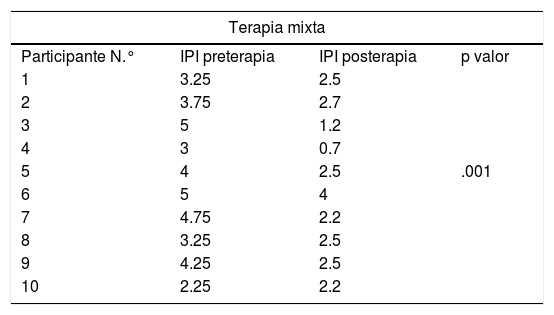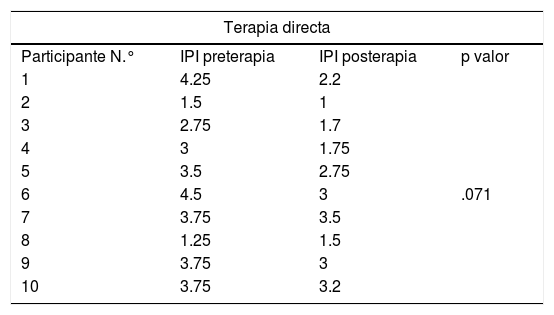La terapia de voz es una práctica que no está ampliamente fundamentada en la evidencia investigativa; la valoración y el seguimiento de los programas de rehabilitación se apoyan casi exclusivamente en el análisis perceptual y pocas evaluaciones acústicas reportan medidas que no se han interrelacionado entre sí para determinar grados de riesgo vocal en diferentes poblaciones con disfonía.
El objetivo de esta investigación fue valorar acústicamente el efecto de 2tipos de terapia vocal (mixta y directa) en personas con disfonía funcional empleando el índice de perturbación vocal integrado.
MétodoSe seleccionó una muestra de 20 personas entre los 20 y 60 años con disfonía funcional; se evaluó toda la muestra mediante análisis acústico con el software Anagraf y se fraccionó la muestra en 2grupos, el primero recibió terapia vocal mixta y el segundo únicamente terapia vocal directa. Se evaluaron acústicamente las voces, posterior a la terapia, y se comparó el efecto de los 2tipos de intervención propuestos.
ResultadosEl índice de perturbación vocal integrado se encontró alterado para la mayor parte de la muestra de ambos grupos, preterapia vocal. Finalizada la terapia tanto mixta como directa, se encontró que este índice clasificó voces en rangos de normalidad y voces en riesgo disminuyendo su grado de alteración.
ConclusiónEl índice de perturbación vocal integrado se modificó favorablemente para ambos grupos de terapia. No obstante, esta modificación fue estadísticamente significativa para el grupo que realizó terapia vocal mixta.
Voice therapy is a practice that is not extensively based on research evidence; the assessment and monitoring of rehabilitation programmes are generally based on perceptual analysis, and few acoustic measures have not been correlated with each other to determine the extent of vocal risk among different kinds of populations with dysphonia.
The aim of this research was the acoustic assessment of the effect of 2types of voice therapy (mixed and direct) in individuals with functional dysphonia using the integrated vocal disturbance index.
MethodA sample of 20 functional dysphonic individuals aged between 20 and 60 years was selected. The individuals were assessed through an acoustic analysis using Anagraf software. The sample was split into 2groups; the first one received mixed voice therapy and the second only received direct voice therapy. The post-therapy voices were acoustically assessed, comparing the effect of the techniques proposed.
ResultsThe integrated vocal disturbance index was found to be altered for most of the individuals in both groups before receiving voice therapy. On completion of the mixed and direct voice therapy, it was found that the index classified the voices into normal and at risk, decreasing their extent of disturbance.
ConclusionThe integrated vocal disturbance index was favourably modified for both therapy groups. However, this was statistically more significant for the group that received mixed voice therapy.
Artículo
Comprando el artículo el PDF del mismo podrá ser descargado
Precio 19,34 €
Comprar ahora













